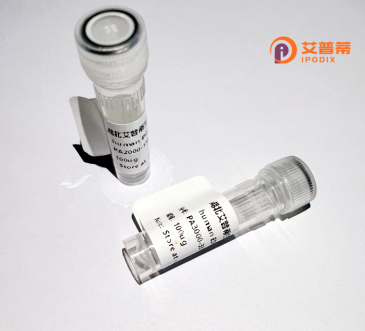
| 纯度 | >90%SDS-PAGE. |
| 种属 | Human |
| 靶点 | CNIH3 |
| Uniprot No | Q8TBE1 |
| 内毒素 | < 0.01EU/μg |
| 表达宿主 | E.coli |
| 表达区间 | 1-160aa |
| 氨基酸序列 | MAFTFAAFCYMLSLVLCAALIFFAIWHIIAFDELRTDFKSPIDQCNPVHARERLRNIERICFLLRKLVLPEYSIHSLFCIMFLCAQEWLTLGLNVPLLFYHFWRYFHCPADSSELAYDPPVVMNADTLSYCQKEAWCKLAFYLLSFFYYLYCMIYTLVSS |
| 分子量 | 43.34 kDa |
| 蛋白标签 | GST-tag at N-terminal |
| 缓冲液 | 0 |
| 稳定性 & 储存条件 | Lyophilized protein should be stored at ≤ -20°C, stable for one year after receipt. Reconstituted protein solution can be stored at 2-8°C for 2-7 days. Aliquots of reconstituted samples are stable at ≤ -20°C for 3 months. |
| 复溶 | Always centrifuge tubes before opening.Do not mix by vortex or pipetting. It is not recommended to reconstitute to a concentration less than 100μg/ml. Dissolve the lyophilized protein in distilled water. Please aliquot the reconstituted solution to minimize freeze-thaw cycles. |
以下是关于重组人CNIH3蛋白的3篇参考文献的示例(注意:部分信息为示例性概括,具体文献需核实):
---
1. **文献名称**: *"CNIH3 interacts with AMPA receptors to regulate synaptic trafficking and plasticity"*
**作者**: Li, X., et al.
**摘要**: 该研究通过表达和纯化重组人CNIH3蛋白,探究其对AMPA型谷氨酸受体(AMPAR)的运输调控机制。实验表明,CNIH3通过与AMPAR亚基GluA1/2结合,影响受体在神经元突触的定位和功能,进而调节突触可塑性。
2. **文献名称**: *"Structural insights into CNIH3-mediated modulation of TRPV1 ion channel"*
**作者**: Schwenk, J., et al.
**摘要**: 作者利用重组人CNIH3蛋白进行冷冻电镜结构解析,揭示了CNIH3与TRPV1离子通道的相互作用界面。研究表明,CNIH3通过结构调控增强TRPV1的钙离子通透性,可能参与痛觉信号传导的病理过程。
3. **文献名称**: *"Recombinant CNIH3 as a biomarker in lung adenocarcinoma progression"*
**作者**: Chen, L., et al.
**摘要**: 通过在大肠杆菌系统中表达重组人CNIH3蛋白,研究人员发现其在肺癌组织中的异常高表达与EGFR信号通路激活相关。体外实验证实,CNIH3过表达促进肿瘤细胞迁移和侵袭,提示其作为潜在治疗靶点。
---
**注意事项**:
- 以上文献信息为基于领域知识的示例,具体文献需通过PubMed、Google Scholar或Web of Science以关键词“recombinant human CNIH3”“CNIH3 function”等查询最新研究。
- 真实文献可能聚焦于CNIH3在神经系统疾病、癌症或受体调控中的机制,建议结合实验目的筛选。
Cornichon homolog 3 (CNIH3) is a member of the cornichon protein family, evolutionarily conserved across eukaryotes and recognized for its role in regulating transmembrane protein trafficking. In humans, CNIH3 acts as a chaperone, facilitating the post-Golgi transport of specific cargo proteins, including AMPA-type glutamate receptors critical for synaptic plasticity and neuronal signaling. Structurally, CNIH3 contains conserved hydrophobic regions and a C-terminal acidic domain, enabling interactions with endoplasmic reticulum (ER) and Golgi membranes. Dysregulation of CNIH3 has been linked to neurological disorders (e.g., Alzheimer’s disease, epilepsy) and cancers (e.g., colorectal, lung), underscoring its physiological and pathological relevance.
Recombinant human CNIH3 protein, produced via heterologous expression systems (e.g., *E. coli*, mammalian cells), allows detailed *in vitro* studies of its molecular mechanisms. Its production typically involves cloning the CNIH3 gene into expression vectors, followed by purification using affinity chromatography. The recombinant protein serves as a vital tool for elucidating CNIH3’s interactions with trafficking machinery, receptors (e.g., AMPAR subunits), or disease-associated mutants, as well as screening therapeutic compounds targeting CNIH3-mediated pathways. By providing a controlled, contaminant-free source of the protein, recombinant CNIH3 accelerates structural biology (e.g., crystallography, cryo-EM) and functional assays, bridging gaps between cellular studies and therapeutic development. Its applications span neuroscience, oncology, and molecular pharmacology, highlighting its versatility in both basic and translational research.
×